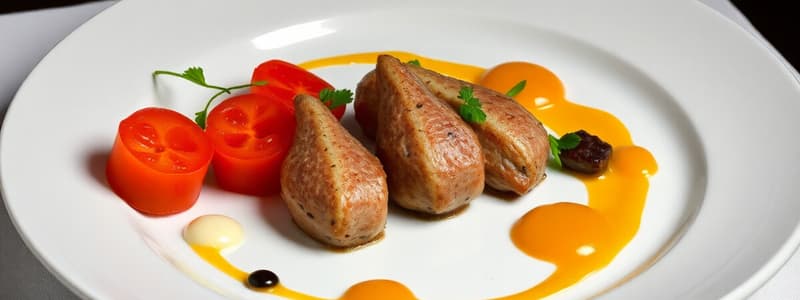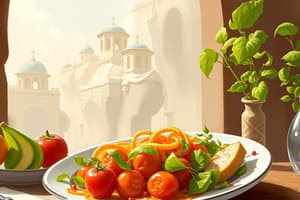Podcast
Questions and Answers
Which culinary movement emphasizes simplified dishes and the highlighting of natural flavors, contrasting with the rich sauces and complex preparations of classic French cuisine?
Which culinary movement emphasizes simplified dishes and the highlighting of natural flavors, contrasting with the rich sauces and complex preparations of classic French cuisine?
- Molecular Gastronomy
- Slow Food
- Nouvelle Cuisine (correct)
- Modernist Cuisine
A restaurant is committed to using locally sourced ingredients, traditional cooking methods, and promoting regional culinary heritage. Which culinary movement best aligns with this restaurant's philosophy?
A restaurant is committed to using locally sourced ingredients, traditional cooking methods, and promoting regional culinary heritage. Which culinary movement best aligns with this restaurant's philosophy?
- Slow Food (correct)
- Molecular Gastronomy
- Nouvelle Cuisine
- Modernist Cuisine
A chef is experimenting with foams, gels, and spherification to deconstruct and reimagine traditional dishes. Which culinary approach is the chef primarily utilizing?
A chef is experimenting with foams, gels, and spherification to deconstruct and reimagine traditional dishes. Which culinary approach is the chef primarily utilizing?
- Traditional French Cuisine
- Nouvelle Cuisine
- Slow Food
- Molecular Gastronomy (correct)
Which culinary trend involves using advanced technology and scientific techniques to create avant-garde dishes, often focusing on texture and presentation?
Which culinary trend involves using advanced technology and scientific techniques to create avant-garde dishes, often focusing on texture and presentation?
In which way does Slow Food differ from Nouvelle Cuisine, Molecular Gastronomy, and Modernist Cuisine?
In which way does Slow Food differ from Nouvelle Cuisine, Molecular Gastronomy, and Modernist Cuisine?
Flashcards
Nouvelle Cuisine
Nouvelle Cuisine
Developed in the 1960s, emphasizes lighter, more delicate dishes with intense flavors, natural ingredients, and artistic presentation.
Slow Food
Slow Food
Started in Italy in the 1980s as a reaction to fast food; prioritizes local, sustainable ingredients and traditional cooking methods.
Molecular Gastronomy
Molecular Gastronomy
Applies scientific principles to cooking, exploring the physical and chemical transformations of ingredients during food preparation.
Modernist Cuisine
Modernist Cuisine
Signup and view all the flashcards
Trend Differences
Trend Differences
Signup and view all the flashcards
Study Notes
- The last century has seen significant shifts in culinary trends
- Nouvelle Cuisine, Slow Food, Molecular Gastronomy, and Modernist Cuisine represent some major movements
Nouvelle Cuisine
- Emerged in France in the 1960s as a reaction against classical French cuisine
- Focused on lighter, simpler dishes, emphasizing fresh, high-quality ingredients
- Sauces were lighter, often based on natural reductions instead of heavy cream or butter
- Presentation was a key element, with attention to visual appeal and artistic plating
- Shorter cooking times to preserve the natural flavors and textures of food
- Chefs like Paul Bocuse, Alain Chapel, and the Troisgros brothers were pioneers
- Marked a departure from the rich, elaborate preparations of traditional haute cuisine
- Portions were typically smaller compared to classical cuisine
- Emphasized regional and seasonal ingredients
- Experienced a decline in popularity as chefs moved towards new culinary philosophies
Slow Food
- Founded in Italy in 1986 by Carlo Petrini in response to the opening of a McDonald's in Rome
- Promotes local food and traditional cooking methods
- Aims to counteract the rise of fast food and the homogenization of food culture
- Focuses on preserving regional culinary traditions and biodiversity
- Advocates for sustainable agriculture and responsible food production
- Emphasizes the importance of enjoying food and the social aspects of dining
- Supports small-scale farmers and food producers
- Encourages consumers to be more aware of the origins and production methods of their food
- Seeks to educate people about the importance of food quality and nutrition
- Built on three interconnected principles: good, clean, and fair food
- Continues to be a global movement, with chapters in numerous countries
Molecular Gastronomy
- A scientific approach to cooking that investigates the physical and chemical transformations of ingredients that occur during cooking
- Explores the use of new techniques and equipment in the kitchen
- Hervé This and Nicholas Kurti are considered pioneers of the discipline
- Focuses on understanding the mechanisms behind culinary processes
- Involves techniques like spherification, sous-vide cooking, and the use of liquid nitrogen
- Aims to create new flavors, textures, and presentations
- Can involve deconstructing traditional dishes and reassembling them in novel ways
- Ferran Adrià of elBulli restaurant was a prominent figure in popularizing these techniques
- Often seen as experimental and avant-garde
- Provokes discussion about the role of science in cooking
- Sometimes criticized for being overly focused on technique at the expense of flavor
- Extends beyond cooking into areas such as food preservation and sensory perception
Modernist Cuisine
- A culinary movement that builds upon the principles of molecular gastronomy
- Emphasizes a deep understanding of scientific principles
- Explores innovative techniques and equipment to create dishes
- Characterized by a systematic and experimental approach to cooking
- Aims to push the boundaries of culinary possibilities
- Often involves the use of precise measurements and controlled environments
- Focuses on achieving specific textures, flavors, and presentations
- Nathan Myhrvold's "Modernist Cuisine: The Art and Science of Cooking" is a seminal work
- Encompasses a wide range of techniques, from sous vide to spherification to foams and gels
- Stresses the importance of documentation and sharing of knowledge
- Can be seen as a continuation of the avant-garde spirit of molecular gastronomy
- Acknowledges that tradition and innovation can coexist in the culinary world
Studying That Suits You
Use AI to generate personalized quizzes and flashcards to suit your learning preferences.
Description
Explore the culinary shifts of the last century, focusing on Nouvelle Cuisine and Slow Food movements. Nouvelle Cuisine emerged in France in the 1960s, emphasizing lighter, simpler dishes with fresh ingredients. Slow Food focuses on preserving regional culinary traditions, promoting local ingredients, and sustainable practices.




